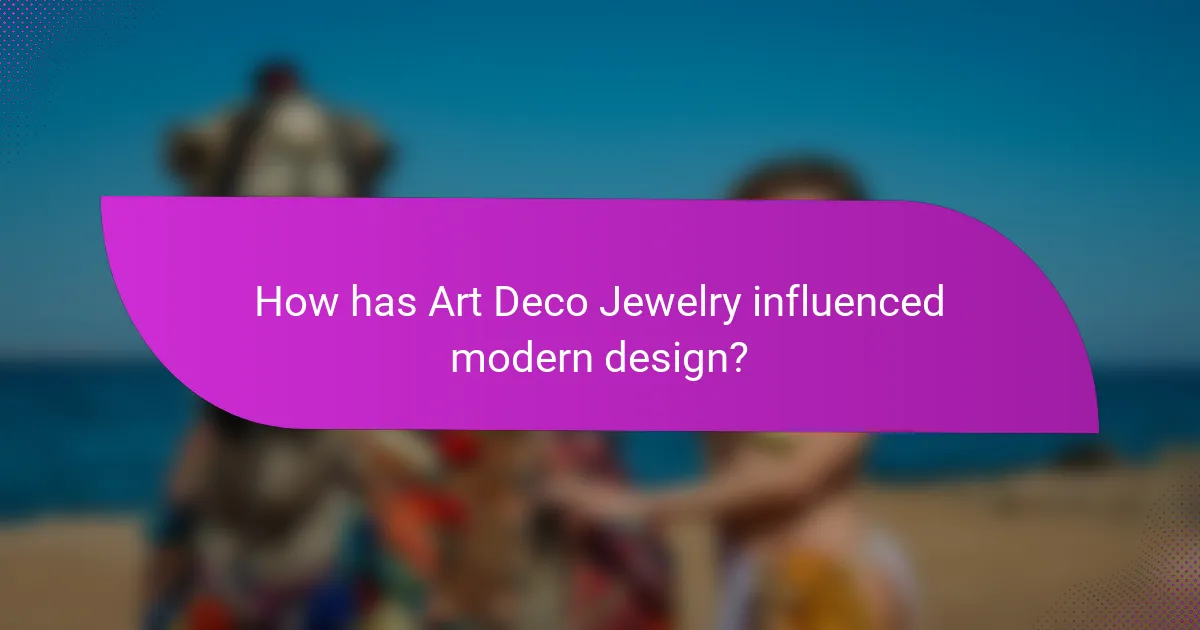Art Deco jewelry is a distinctive style of decorative art that originated in the 1920s and 1930s, marked by bold geometric shapes, vibrant colors, and luxurious materials such as diamonds and platinum. This jewelry style reflects various influences, including cubism and ancient cultures, and emphasizes symmetry and streamlined forms. The article explores the characteristics and iconic designs of Art Deco jewelry, its lasting impact on modern design, and considerations for purchasing authentic pieces. Key motifs like chevrons and zigzags, along with the importance of craftsmanship and historical context, are also discussed to guide collectors and enthusiasts in their appreciation of this enduring style.

What is Art Deco Jewelry?
Art Deco jewelry is a style of decorative art that emerged in the 1920s and 1930s. It is characterized by bold geometric shapes, vibrant colors, and luxurious materials. Art Deco jewelry often incorporates diamonds, platinum, and colored gemstones. The movement reflects influences from various sources, including cubism, the Bauhaus, and ancient cultures. Its designs emphasize symmetry and streamlined forms. Art Deco jewelry became popular during the Roaring Twenties, symbolizing modernity and progress. This style remains highly sought after by collectors and enthusiasts today.
How did Art Deco Jewelry emerge as a distinct style?
Art Deco Jewelry emerged as a distinct style in the early 20th century. It developed during the 1920s and 1930s, coinciding with the Art Deco movement in art and architecture. The style is characterized by bold geometric shapes and vibrant colors. Influences include the rise of modernism and advancements in technology. Art Deco Jewelry often features materials like platinum, diamonds, and colorful gemstones. The 1925 Exposition Internationale des Arts Décoratifs et Industriels Modernes in Paris showcased this new aesthetic. Designers like Cartier and Van Cleef & Arpels played significant roles in popularizing the style. The combination of luxury and modern design defined Art Deco Jewelry’s unique identity.
What historical events influenced the development of Art Deco Jewelry?
The development of Art Deco Jewelry was influenced by several historical events. The Industrial Revolution introduced new materials and production techniques. This allowed for mass production of jewelry, making it more accessible. The 1925 Exposition Internationale des Arts Décoratifs et Industriels Modernes in Paris showcased the Art Deco style. The Roaring Twenties brought a cultural shift towards modernism and luxury. The rise of jazz music and flapper culture emphasized bold and extravagant designs. Additionally, the aftermath of World War I led to a desire for optimism and escapism in art and fashion. These events collectively shaped the aesthetic and thematic elements of Art Deco Jewelry.
What cultural movements contributed to the Art Deco aesthetic?
The Art Deco aesthetic was influenced by several cultural movements. Key movements include Cubism, which emphasized geometric shapes and abstraction. Futurism contributed a sense of dynamism and modernity. The Bauhaus movement introduced functionalism and simplicity in design. Additionally, the Jazz Age brought vibrant colors and a sense of luxury. These movements collectively shaped the distinctive characteristics of Art Deco, such as symmetry and rich ornamentation. The integration of these influences created a unique style that defined the era.
What are the defining characteristics of Art Deco Jewelry?
Art Deco Jewelry is characterized by geometric shapes, bold colors, and intricate designs. It emerged in the 1920s and 1930s, reflecting the modernist movement. Materials such as platinum, gold, and colored gemstones are commonly used. The style often incorporates motifs inspired by nature, architecture, and technology. Art Deco pieces frequently feature symmetrical patterns and streamlined forms. The use of enamel and glass adds vibrancy to the designs. Notable designers include Cartier and Van Cleef & Arpels, who popularized this aesthetic. Art Deco Jewelry remains a symbol of luxury and sophistication.
How do geometric shapes play a role in Art Deco designs?
Geometric shapes are fundamental in Art Deco designs. They create a sense of order and symmetry. Art Deco emphasizes angular forms and bold lines. This style often incorporates chevrons, zigzags, and circles. These shapes contribute to a modern aesthetic, reflecting the era’s technological advancements. The use of geometry in Art Deco aligns with its roots in Cubism and Futurism. Historical examples include the Chrysler Building and various jewelry pieces. These designs showcase the elegance and sophistication of geometric patterns.
What materials are commonly used in Art Deco Jewelry?
Art Deco jewelry commonly uses materials such as platinum, gold, and silver. These metals provide durability and a luxurious appearance. Additionally, gemstones like diamonds, emeralds, and sapphires are frequently incorporated. Art Deco designs often feature vibrant colored stones, including rubies and onyx. Other materials include glass, enamel, and ivory, which add unique textures and colors. The combination of these materials reflects the bold and geometric aesthetic of the Art Deco movement. Historical examples show that the use of these materials was prevalent during the 1920s and 1930s, highlighting their significance in this jewelry style.
How does color influence the appeal of Art Deco pieces?
Color significantly influences the appeal of Art Deco pieces. Art Deco is characterized by vibrant colors and geometric patterns. These colors evoke emotions and attract attention. Bold hues like emerald green, deep blue, and rich red dominate the style. Such colors contribute to a sense of luxury and modernity. The color palette reflects the optimism of the 1920s and 1930s. Additionally, contrasting colors enhance visual interest and depth. Historical context shows that color choices in Art Deco were influenced by advancements in dye technology. This allowed for a wider range of vibrant colors in materials.
What iconic designs exemplify Art Deco Jewelry?
Iconic designs that exemplify Art Deco jewelry include geometric patterns, bold colors, and intricate craftsmanship. These designs often feature materials like platinum, diamonds, and colored gemstones. Notable pieces include the Tutti Frutti jewelry by Cartier, which showcases vibrant colored stones in intricate designs. The use of motifs such as chevrons and sunbursts is also characteristic of this style. Art Deco jewelry emerged in the 1920s and 1930s, reflecting the era’s modernity and luxury. The influence of ancient cultures, such as Egyptian and Aztec, is evident in many designs. Prominent designers like Van Cleef & Arpels contributed significantly to this movement. Their works remain highly sought after by collectors today.
Who are some renowned designers associated with Art Deco Jewelry?
Renowned designers associated with Art Deco jewelry include Cartier, Van Cleef & Arpels, and Tiffany & Co. Cartier was known for its innovative designs and use of precious materials during the Art Deco period. Van Cleef & Arpels incorporated unique techniques like the invisible setting in their jewelry. Tiffany & Co. contributed to the movement with their elegant and geometric designs. These designers played a significant role in defining the aesthetic of Art Deco jewelry through their craftsmanship and creativity.
What are notable pieces that represent Art Deco craftsmanship?
Notable pieces that represent Art Deco craftsmanship include the Chrysler Building, the Streamline Moderne furniture, and Cartier’s Tutti Frutti jewelry. The Chrysler Building, completed in 1930, showcases iconic Art Deco architecture with its geometric shapes and ornamental spire. Streamline Moderne furniture features smooth lines and metallic finishes, emphasizing the movement towards modernity in design. Cartier’s Tutti Frutti jewelry, created in the 1920s, is celebrated for its vibrant colors and intricate designs, reflecting the fusion of Eastern and Western influences in Art Deco style. These pieces exemplify the distinctive characteristics of Art Deco, including bold geometric patterns, luxurious materials, and a focus on elegance and innovation.

How has Art Deco Jewelry influenced modern design?
Art Deco Jewelry has significantly influenced modern design through its bold geometric shapes and vibrant colors. This style, popularized in the 1920s and 1930s, emphasized luxury and craftsmanship. Modern jewelry designers often reference Art Deco motifs, such as chevrons and zigzags. The use of contrasting materials, like gold and enamel, is also a hallmark of this era. Many contemporary pieces incorporate similar color palettes inspired by Art Deco aesthetics. Additionally, the emphasis on symmetry and streamlined forms can be seen in today’s jewelry trends. Art Deco’s influence extends beyond jewelry, impacting fashion and interior design as well. These characteristics continue to resonate in modern design, showcasing the enduring legacy of Art Deco.
What elements of Art Deco can be seen in contemporary jewelry?
Contemporary jewelry often incorporates geometric shapes, a hallmark of Art Deco design. This includes sharp angles and bold lines that evoke the era’s architectural influences. Additionally, vibrant colors are prevalent, reflecting the Art Deco preference for rich hues and contrasting palettes. Materials like enamel and gemstones are frequently used, mirroring the luxurious finishes of the Art Deco period. Symmetry is another key element, with many pieces showcasing balanced designs that echo the style’s emphasis on harmony. Art Deco motifs, such as sunbursts and zigzags, can also be found, adding a distinctive vintage flair to modern creations. These elements collectively demonstrate how contemporary jewelry continues to draw inspiration from the iconic Art Deco movement.
How do modern designers reinterpret Art Deco motifs?
Modern designers reinterpret Art Deco motifs by blending geometric shapes with contemporary materials. They often incorporate bold colors and intricate patterns reminiscent of the original style. Designers utilize digital technology to create precise and innovative designs. This approach allows for unique interpretations while maintaining the essence of Art Deco. For instance, many pieces feature angular lines and symmetrical patterns. Additionally, the use of sustainable materials reflects current design trends. This fusion creates a fresh perspective on classic motifs. Overall, modern interpretations pay homage to the past while embracing the future of design.
Why is Art Deco Jewelry still relevant today?
Art Deco jewelry remains relevant today due to its timeless elegance and distinctive style. This design movement, which flourished in the 1920s and 1930s, combines geometric shapes with luxurious materials. The bold colors and intricate patterns continue to attract modern audiences. Many contemporary designers draw inspiration from Art Deco aesthetics. Additionally, the jewelry’s historical significance adds to its allure. Collectors and enthusiasts value pieces for their craftsmanship and uniqueness. The resurgence of vintage fashion trends has also contributed to its popularity. Art Deco jewelry symbolizes a bygone era of sophistication that resonates with current tastes.
What trends in fashion have revived interest in Art Deco styles?
Recent trends in fashion that have revived interest in Art Deco styles include vintage-inspired collections and bold geometric patterns. Designers are increasingly incorporating Art Deco motifs into contemporary apparel. The resurgence of 1920s and 1930s aesthetics in runway shows has sparked renewed fascination. High-profile fashion events often showcase Art Deco influences in accessories and jewelry. Social media platforms amplify this trend, with influencers promoting vintage looks. Additionally, the popularity of sustainable fashion encourages the reuse of vintage Art Deco pieces. This combination of nostalgia and modernity fuels ongoing interest in Art Deco styles.
How do collectors value Art Deco Jewelry in the current market?
Collectors value Art Deco Jewelry in the current market based on its rarity, craftsmanship, and historical significance. The demand for well-preserved pieces has increased due to the resurgence of interest in vintage styles. Factors such as the materials used, including precious metals and gemstones, also influence value. Provenance, or the item’s history, plays a crucial role in establishing authenticity and desirability. Recent auction results show that high-quality Art Deco pieces can fetch significant sums, often exceeding estimates. Market trends indicate that collectors are particularly interested in unique designs and limited editions. Overall, the valuation process combines aesthetic appeal with market dynamics and historical context.

What tips should one consider when purchasing Art Deco Jewelry?
When purchasing Art Deco Jewelry, consider authenticity and craftsmanship. Authentic pieces often feature geometric designs and bold colors. Examine the materials used, such as platinum, gold, and gemstones. Check for quality marks or signatures from reputable designers. Understand the historical context; Art Deco spanned from the 1920s to the 1930s. Familiarize yourself with common motifs like zigzags and chevrons. Research current market values to avoid overpaying. Finally, seek out reputable dealers or auction houses for a trustworthy purchase experience.
How can buyers identify authentic Art Deco pieces?
Buyers can identify authentic Art Deco pieces by examining specific design characteristics. Authentic Art Deco often features geometric shapes, bold colors, and luxurious materials. Look for intricate craftsmanship and detailed motifs, such as chevrons and zigzags. Authentic pieces typically use materials like platinum, gold, and high-quality gemstones.
Buyers should also check for maker’s marks or signatures from known Art Deco designers. Researching reputable sources and auction houses can provide insight into authentic pieces. Understanding the historical context of Art Deco, which flourished from the 1920s to the 1940s, is essential. This period emphasized modernity and elegance, influencing the design elements found in genuine items.
What factors affect the valuation of Art Deco Jewelry?
The valuation of Art Deco Jewelry is influenced by several key factors. These factors include the quality of materials used, such as gemstones and metals. The craftsmanship and design intricacies also play a significant role in determining value. Historical significance and provenance can enhance the worth of specific pieces. The condition of the jewelry, including any repairs or restorations, affects its valuation. Market demand for Art Deco styles can fluctuate, impacting prices. Lastly, the rarity of the piece, including unique attributes, contributes to its overall valuation.
How can buyers ensure they are making a wise investment?
Buyers can ensure they are making a wise investment by thoroughly researching the Art Deco jewelry market. They should examine the authenticity of pieces, as genuine Art Deco items often have specific design characteristics. Buyers should also consider the provenance of the jewelry, as items with a well-documented history tend to retain value better. Consulting reputable appraisers or experts can provide valuable insights into the quality and worth of specific pieces. Furthermore, understanding market trends and demand for Art Deco jewelry can guide buyers in making informed decisions. According to a report by the Antique Jewelry University, authentic Art Deco jewelry has seen a consistent appreciation in value over the past decade, indicating a strong investment potential.
Art Deco Jewelry is a distinctive style that emerged in the 1920s and 1930s, characterized by bold geometric shapes, vibrant colors, and luxurious materials such as platinum, diamonds, and colored gemstones. The movement was influenced by various cultural and historical factors, including modernism, the Industrial Revolution, and significant events like the 1925 Exposition Internationale des Arts Décoratifs et Industriels Modernes. Key features include intricate designs, symmetry, and motifs inspired by nature and technology, with renowned designers like Cartier and Van Cleef & Arpels playing pivotal roles in its popularity. The article explores the defining characteristics, historical influences, and iconic designs of Art Deco jewelry, as well as its lasting impact on contemporary design and its relevance in today’s market.